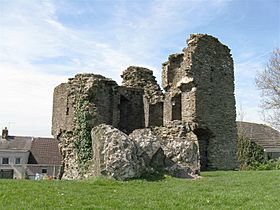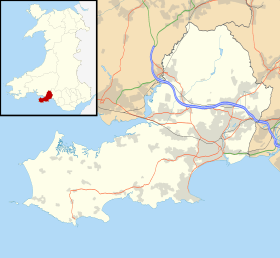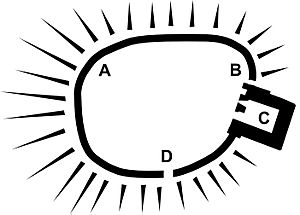Loughor Castle facts for kids
Quick facts for kids Loughor Castle |
|
|---|---|
| Loughor, Wales | |

The ruined stone tower at Loughor Castle
|
|
| Coordinates | 51°39′44″N 4°04′39″W / 51.6622°N 4.0774°W |
| Type | Ringwork |
| Site information | |
| Owner | Cadw |
| Open to the public |
Yes |
| Site history | |
| In use | Tourist attraction |
| Materials | Stone |
Loughor Castle is an old, ruined castle in the town of Loughor, Wales. It was built around 1106 by a powerful Anglo-Norman lord named Henry de Beaumont. This was during the time when the Normans were taking over parts of Wales.
The castle was built in a very important spot. It looked over the River Loughor and controlled a main road and a shallow river crossing, called a ford. This ford was used to cross the Gower Peninsula. The castle was first built as an oval-shaped ringwork. This means it was a circular earth mound with defenses on top. It even reused parts of an older Roman fort called Leucarum.
For the next 200 years, Loughor Castle was part of many fights. It was attacked and burned in 1151. Later, in 1215, Llywelyn the Great captured it. In 1220, John de Braose took over and fixed the castle. He added strong stone walls to replace the older defenses. The castle was attacked again in 1251. After this, a stone tower was added in the late 1200s.
Over time, the castle became less important. By the 1800s, it was a ruin covered in ivy. Today, Loughor Castle is looked after by Cadw, a Welsh heritage group. It is now a popular place for tourists to visit. You can still see the ruined tower and parts of the stone walls. These stand on top of the original earth mound, which now looks like a motte, or a small hill.
Contents
History of Loughor Castle
Roman beginnings (1st–4th centuries)
Loughor Castle is about 11 kilometers (7 miles) west of Swansea in South-West Wales. It sits high above the River Loughor. This spot was first used by the Romans for a military fort. This fort was one of many built across South-West Wales.
The Roman fort was called Leucarum. Its name came from the Celtic name for the River Loughor. The location was great because it offered clear views of the area. It also helped support Roman ships in the Bristol Channel. The fort controlled a ford across the river. This ford was likely used even before the Romans arrived.
The Romans built the fort around 75 AD. They used it until the mid-100s. Then, they came back and used it again in the late 200s and early 300s. Finally, the Roman army left the fort for good.
Norman arrival (11th–12th centuries)
The Normans started moving into South Wales from the late 1060s. They pushed west from their bases in England. They often built castles on old Roman sites. This saved a lot of effort in building large earth defenses. Places like Cardiff Castle, Pevensey Castle, and Portchester Castle are examples.
Loughor Castle was built on the western edge of a Welsh land area called Gwyr. It was built soon after 1106. That's when Henry de Beaumont, the Earl of Warwick, was given the Gower Peninsula by King Henry I. The Anglo-Normans then settled the area. Gower became a Marcher territory, meaning it had a lot of local freedom.
Loughor Castle was very important. It controlled the main road through Gower from Beaumont's main castle in Swansea Castle. It was also a valuable port on the coast. The castle's name came from a changed version of the old Roman fort's name.
In the 1100s, the castle was protected on its south side by a steep slope. There was also marshy ground along the river. The castle was built as an oval ringwork. Today, this ringwork is about 21 meters (69 feet) by 18 meters (59 feet) across and 12 meters (39 feet) high. It had a ditch around it that was 5 meters (16 feet) wide and 2 meters (7 feet) deep.
The Roman fort was only visible as earth mounds in the 1100s. The castle builders used parts of these mounds for their ringwork. The ringwork was made of river gravel and sand. It had a protective wicker fence around the top. There might have been an early stone or wooden tower too, with a gate nearby. We don't know much about the buildings inside the ringwork, but there was a kitchen on the east side.
The early 1100s were a time of much fighting in Gower. The Anglo-Normans and the local Welsh fought often. Loughor Castle was attacked and burned around the mid-1100s. This was likely part of a Welsh uprising in 1151. Later, King Henry II and the Welsh prince Rhys ap Gruffydd made peace. The castle was then rebuilt.
During the 1151 attack, the inside of the ringwork filled with rubble. Later, the bank of the ringwork was made wider inwards. This allowed buildings to be built on it. These changes started to fill the middle of the ringwork. This is why the castle today has a mound-like, or motte-like, look.
Around the late 1100s, two stone buildings were added inside the ringwork. One was about 8 meters (26 feet) by 4.5 meters (15 feet). The King of England likely took control of the castle around this time. This was probably because the Earl of Warwick owed him money. More fighting broke out in South-West Wales in 1189. Rhys and his sons tried to take back the region.
Stone additions and conflicts (13th–14th centuries)
Fighting continued in Gower during the 1200s. King John gave Loughor Castle to his friend William de Braose in 1203. William was a powerful lord and related to Rhys ap Gruffudd. But in 1208, King John and William argued. The king tried to take Loughor and William's other lands. William then joined forces with the Welsh prince Llywelyn the Great.
William died in 1211, but his son, Reginald, kept fighting. Reginald married Gwladus, Llywelyn's daughter. In 1215, Llywelyn's army captured the castle. Control of Gower was given to Reginald. However, two years later, Reginald made peace with the English King. Llywelyn then removed him from power. He replaced him with the Welsh prince Rhys Gryg. Old records say that Rhys Gryg destroyed all the castles in Gower. He did this to show his power in the area.
Llywelyn married another daughter, Margaret, to Reginald's nephew, John de Braose. In 1220, Llywelyn gave John Gower and Loughor Castle. John then started repairing the castle. As part of this work, a stone curtain wall was built around the castle. This wall included a sally port, which is a secret exit, on the north side.
In 1232, John's son, William, inherited the castle. Later, his son, also named William, took over. In the second half of the 1200s, fighting started again in Wales. The castle was attacked in 1251. It was decided to make the castle stronger. A square stone tower was added. This tower had three rooms and was used for living. The first floor had a garderobe (a medieval toilet) and a fireplace. A new gate was built through the curtain wall, just south of the tower. Two more stone buildings were also built inside the castle walls.
In 1302, William de Braose gave the Loughor estate to his manager, John Yweyn. John would pay a yearly fee of a greyhound collar. When John Yweyn died in 1322, the lands were taken by John de Mowbray. He was William's son-in-law. However, John de Mowbray was part of a rebellion against King Edward II. He was executed later in 1322. John Yweyn's relative, Alice Roculf, asked the king for the lands and got them. King Edward lost power in 1327. The Loughor lands were then given to John de Mowbray's son, John.
Later years and today (15th–21st centuries)
Loughor Castle and the town around it became less important in the late medieval period. By the 1800s, the castle had been a ruin for many years. It was completely covered in ivy. An artist named William Butler painted the castle in the 1850s. His painting showed the ruins next to local factories and a new railway line. This railway had been built through the old Roman fort.
In the 1940s, a corner of the castle tower fell down. It fell to the ground in one piece. Because it was so old and important, people decided to leave the fallen stones where they were. This was to avoid damaging them more by trying to move them. In 1946, the castle was given to the Ministry of Works. Now, the Welsh heritage group Cadw looks after it. It is open to the public as a tourist attraction. The castle is located inside the small Loughor Castle Park.
Archaeologists studied the castle between 1969–71 and in 1973. The castle is now a scheduled monument under UK law. This means it is protected. Much of the original stone wall has been taken or destroyed since medieval times. However, parts of it still remain up to 1.5 meters (5 feet) high. The ruins of the tower are still a very noticeable part of the local area.



